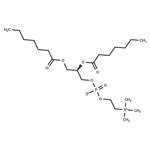Definition
ChEBI: 1,2-diheptanoyl-sn-glycero-3-phosphocholine is a phosphatidylcholine 14:0 in which both acyl groups are specified as heptanoyl. It has a role as a detergent. It is functionally related to a heptanoic acid.
Biological Activity
DHPC preserves the native conformation and therefore the activity of the solubilized proteins. The three dimensional structure and activity of proteins are retained not only at the 10-15mM DHPC concentrations at which maximum solubilization usually occurs, but also over a large range of DHPC concentrations (up to 40mM). Not only is the three dimensional structure and hence the activity of most protein retained in excess DHPC, but the proteins also appear to be stable in DHPC. Such a result suggests th at the direct interaction of DHPC with integral membrane proteins is weak. If the interaction of DHPC with membrane proteins is indeed weak, it follows th at intrinsic membrane lipids will remain associated with the membrane proteins. Solubilization Mechanism DHPC is thought to exert a wedge-like effect on the neighboring lipids, mainly due to its bulky polar group and short hydrocarbon chains. This produces membrane destabilization at relatively low DHPC concentrations. All membranes investigated are solubilized at an identical DHPC / lipid ratio. This finding is taken as evidence th at DHPC primarily interacts with the lipid bilayer and not with the membrane proteins. The principle underlying the preservation of the native protein structure is the inability of DHPC to displace intrinsic membrane lipids from integral membrane proteins.Advantages of DHPC: DHPC preserves the activity of solubilized membrane proteins. DHPC is not readily oxidized, and is stable over a wide pH range (4-10). DHPC forms micelles rather than bilayers when dispersed in water. (CMC = 1.4mM). DHPC shows a broad size distribution depending on the NaCl concentration of suspension. DHPC does not interfere with spectrophotometric measurements.

